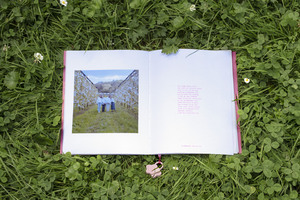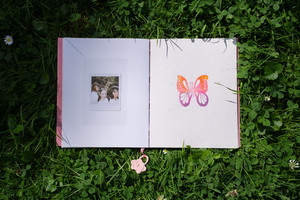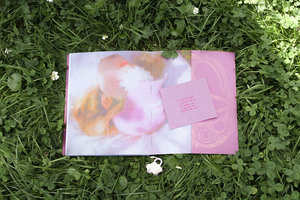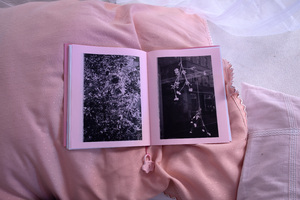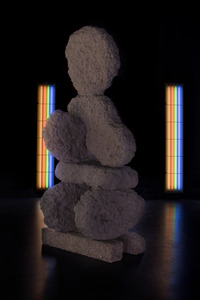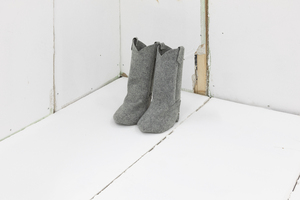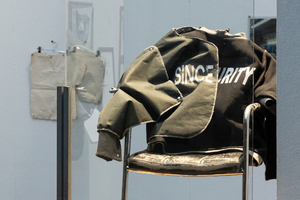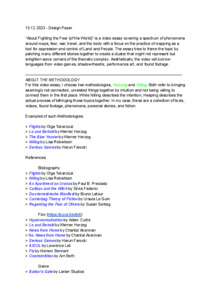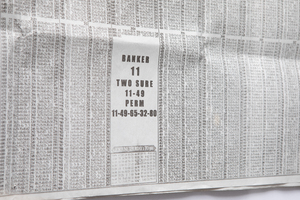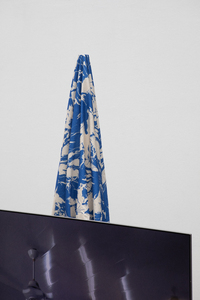"Kommunikationsdesign"
| Begriff | Kommunikationsdesign |
| Metakey | Studiengang (institution:program_of_study) |
| Typ | Keyword |
| Vokabular | HfG |
419 Inhalte
- Seite 1 von 35
Buch eternal girlhood
- Titel
- Buch eternal girlhood
- Schlagworte
- Datierung
- 06.07.24
- Titel
- Buch eternal girlhood
- Titel (en)
- Book eternal girlhood
- Urheberrechtshinweis
- © Joanne Dietz
- Freigabe Nutzung HfG
- Medienersteller/in
- Beziehung/Funktion
- Medien-Beschreibung
- Ansichten der Publikation.
Kapitel mit unterschiedlichen Papieren und Druckmethoden (Digital, Riso), handgebunden, mit geprägtem glitzernden Umschlag und Schloss-Anhänger.
- Ansichten der Publikation.
- Medien-Beschreibung (en)
- Views of the Book.
Chapters of different papers and printing methods (digital, riso), handbound, with embossed glitter dustcover and charm lock.
- Views of the Book.
- Projektleiter/in
- Semester
- Studiengang
- Typ der Abschlussarbeit
- Importiert am
- 20.01.2025
- Übergeordnete Sets
- 1
Buch eternal girlhood
- Titel
- Buch eternal girlhood
- Schlagworte
- Datierung
- 06.07.24
- Titel
- Buch eternal girlhood
- Titel (en)
- Book eternal girlhood
- Urheberrechtshinweis
- © Joanne Dietz
- Freigabe Nutzung HfG
- Medienersteller/in
- Beziehung/Funktion
- Medien-Beschreibung
- Ansichten der Publikation.
Kapitel mit unterschiedlichen Papieren und Druckmethoden (Digital, Riso), handgebunden, mit geprägtem glitzernden Umschlag und Schloss-Anhänger.
- Ansichten der Publikation.
- Medien-Beschreibung (en)
- Views of the Book.
Chapters of different papers and printing methods (digital, riso), handbound, with embossed glitter dustcover and charm lock.
- Views of the Book.
- Projektleiter/in
- Semester
- Studiengang
- Typ der Abschlussarbeit
- Importiert am
- 20.01.2025
- Übergeordnete Sets
- 1
Buch eternal girlhood
- Titel
- Buch eternal girlhood
- Schlagworte
- Datierung
- 06.07.24
- Titel
- Buch eternal girlhood
- Titel (en)
- Book eternal girlhood
- Urheberrechtshinweis
- © Joanne Dietz
- Freigabe Nutzung HfG
- Medienersteller/in
- Beziehung/Funktion
- Medien-Beschreibung
- Ansichten der Publikation.
Kapitel mit unterschiedlichen Papieren und Druckmethoden (Digital, Riso), handgebunden, mit geprägtem glitzernden Umschlag und Schloss-Anhänger.
- Ansichten der Publikation.
- Medien-Beschreibung (en)
- Views of the Book.
Chapters of different papers and printing methods (digital, riso), handbound, with embossed glitter dustcover and charm lock.
- Views of the Book.
- Projektleiter/in
- Semester
- Studiengang
- Typ der Abschlussarbeit
- Importiert am
- 20.01.2025
- Übergeordnete Sets
- 1
Buch eternal girlhood
- Titel
- Buch eternal girlhood
- Schlagworte
- Datierung
- 06.07.24
- Titel
- Buch eternal girlhood
- Titel (en)
- Book eternal girlhood
- Urheberrechtshinweis
- © Joanne Dietz
- Freigabe Nutzung HfG
- Medienersteller/in
- Beziehung/Funktion
- Medien-Beschreibung
- Ansichten der Publikation.
Kapitel mit unterschiedlichen Papieren und Druckmethoden (Digital, Riso), handgebunden, mit geprägtem glitzernden Umschlag und Schloss-Anhänger.
- Ansichten der Publikation.
- Medien-Beschreibung (en)
- Views of the Book.
Chapters of different papers and printing methods (digital, riso), handbound, with embossed glitter dustcover and charm lock.
- Views of the Book.
- Projektleiter/in
- Semester
- Studiengang
- Typ der Abschlussarbeit
- Importiert am
- 20.01.2025
- Übergeordnete Sets
- 1
Chicken-Nugget-Monolith
- Titel
- Chicken-Nugget-Monolith
- Autor/in
- Kategorie
- Titel
- Chicken-Nugget-Monolith
- Titel (en)
- Chicken Nugget Monolith
- Urheberrechtshinweis
- © Jannis Zell
- Rechtsschutz/Lizenz
- Freigabe Nutzung HfG
- Medienersteller/in
- Beziehung/Funktion
- Medien-Beschreibung
- "Normalerweise dauert die Evolution Millionen von Jahren, aber hier hat es nur Jahrzehnte gedauert, um eine neue Tierform hervorzubringen, die das Potenzial hat, eine Markerspezies des Anthropozäns zu werden – und die enorme Anzahl dieser weltweit weggeworfenen Hühnerknochen bedeutet, dass wir eine neue Art von Fossil für die zukünftige geologische Aufzeichnung produzieren."
-Professor Jan Zalasiewicz, Professor für Paläobiologie, Universität von Leicester (eigene Übersetzung)
Wir leben im Zeitalter des Huhns.
Die Zeit, die wir auf der Erde verbracht haben, wird durch Reste von Hühnerknochen markiert. Es ist etwa 8000 Jahre her, dass der Mensch das Rote Dschungelhuhn (Gallus Gallus) domestiziert hat - der primäre Vorfahre des Haushuhns.
Die Masse aller 23 Milliarden Hühner, die zu einem bestimmten Zeitpunkt leben, ist größer als die aller anderen Vogelarten zusammen.
Der Chicken Nugget Monolith verehrt das Huhn. Er ist der ikonischsten Form von industriell verarbeitetem Fleisch nachempfunden. Einschließlich aller vier Unterkategorien von Chicken McNuggets: "Bone", "Bell", "Ball" und "Boot".
Modell: 195 × 75 × 85 cm Styropor, Mischung aus mineralischem Gips, Pigmente
- "Normalerweise dauert die Evolution Millionen von Jahren, aber hier hat es nur Jahrzehnte gedauert, um eine neue Tierform hervorzubringen, die das Potenzial hat, eine Markerspezies des Anthropozäns zu werden – und die enorme Anzahl dieser weltweit weggeworfenen Hühnerknochen bedeutet, dass wir eine neue Art von Fossil für die zukünftige geologische Aufzeichnung produzieren."
- Medien-Beschreibung (en)
- “It usually takes millions of years for evolution to occur, but here it has taken just decades to produce a new form of animal that has the potential to become a marker species of the Anthropocene – and the enormous numbers of these chicken bones discarded worldwide means that we are producing a new kind of fossil for the future geological record.”
-Professor Jan Zalasiewicz, Professor of Palaeobiology, University of Leicester
We are living in the age of the chicken.
The time we spent on Earth will be marked by leftover chicken bones. It has been about 8000 years since humans domesticated the Red Jungle Fowl (Gallus Gallus) – The primary progenitor of the domestic chicken.
The mass of all 23 billion chickens living at any given time, is greater than that of all other avian species combined.
The Chicken Nugget Monolith worships the chicken. It is modelled after the most iconic form of industrially processed meat. Including all four subcategories of Chicken McNuggets: “Bone”, “Bell”, “Ball” and “Boot”.
Model: 195 × 75 × 85 cm Styrofoam, mix of mineral plaster, pigments
- “It usually takes millions of years for evolution to occur, but here it has taken just decades to produce a new form of animal that has the potential to become a marker species of the Anthropocene – and the enormous numbers of these chicken bones discarded worldwide means that we are producing a new kind of fossil for the future geological record.”
- Projektleiter/in
- Semester
- Studiengang
- Typ der Abschlussarbeit
- Importiert am
- 31.07.2024
- Übergeordnete Sets
- 1
Chicken-Nugget-Monolith
- Titel
- Chicken-Nugget-Monolith
- Autor/in
- Kategorie
- Titel
- Chicken-Nugget-Monolith
- Titel (en)
- Chicken Nugget Monolith
- Urheberrechtshinweis
- © Jannis Zell
- Rechtsschutz/Lizenz
- Freigabe Nutzung HfG
- Medienersteller/in
- Beziehung/Funktion
- Medien-Beschreibung
- "Normalerweise dauert die Evolution Millionen von Jahren, aber hier hat es nur Jahrzehnte gedauert, um eine neue Tierform hervorzubringen, die das Potenzial hat, eine Markerspezies des Anthropozäns zu werden – und die enorme Anzahl dieser weltweit weggeworfenen Hühnerknochen bedeutet, dass wir eine neue Art von Fossil für die zukünftige geologische Aufzeichnung produzieren."
-Professor Jan Zalasiewicz, Professor für Paläobiologie, Universität von Leicester (eigene Übersetzung)
Wir leben im Zeitalter des Huhns.
Die Zeit, die wir auf der Erde verbracht haben, wird durch Reste von Hühnerknochen markiert. Es ist etwa 8000 Jahre her, dass der Mensch das Rote Dschungelhuhn (Gallus Gallus) domestiziert hat - der primäre Vorfahre des Haushuhns.
Die Masse aller 23 Milliarden Hühner, die zu einem bestimmten Zeitpunkt leben, ist größer als die aller anderen Vogelarten zusammen.
Der Chicken Nugget Monolith verehrt das Huhn. Er ist der ikonischsten Form von industriell verarbeitetem Fleisch nachempfunden. Einschließlich aller vier Unterkategorien von Chicken McNuggets: "Bone", "Bell", "Ball" und "Boot".
Modell: 195 × 75 × 85 cm Styropor, Mischung aus mineralischem Gips, Pigmente
- "Normalerweise dauert die Evolution Millionen von Jahren, aber hier hat es nur Jahrzehnte gedauert, um eine neue Tierform hervorzubringen, die das Potenzial hat, eine Markerspezies des Anthropozäns zu werden – und die enorme Anzahl dieser weltweit weggeworfenen Hühnerknochen bedeutet, dass wir eine neue Art von Fossil für die zukünftige geologische Aufzeichnung produzieren."
- Medien-Beschreibung (en)
- “It usually takes millions of years for evolution to occur, but here it has taken just decades to produce a new form of animal that has the potential to become a marker species of the Anthropocene – and the enormous numbers of these chicken bones discarded worldwide means that we are producing a new kind of fossil for the future geological record.”
-Professor Jan Zalasiewicz, Professor of Palaeobiology, University of Leicester
We are living in the age of the chicken.
The time we spent on Earth will be marked by leftover chicken bones. It has been about 8000 years since humans domesticated the Red Jungle Fowl (Gallus Gallus) – The primary progenitor of the domestic chicken.
The mass of all 23 billion chickens living at any given time, is greater than that of all other avian species combined.
The Chicken Nugget Monolith worships the chicken. It is modelled after the most iconic form of industrially processed meat. Including all four subcategories of Chicken McNuggets: “Bone”, “Bell”, “Ball” and “Boot”.
Model: 195 × 75 × 85 cm Styrofoam, mix of mineral plaster, pigments
- “It usually takes millions of years for evolution to occur, but here it has taken just decades to produce a new form of animal that has the potential to become a marker species of the Anthropocene – and the enormous numbers of these chicken bones discarded worldwide means that we are producing a new kind of fossil for the future geological record.”
- Projektleiter/in
- Semester
- Studiengang
- Typ der Abschlussarbeit
- Importiert am
- 31.07.2024
- Übergeordnete Sets
- 1
Cowboy-Stiefel
- Titel
- Cowboy-Stiefel
- Titel (en)
- a staged performance at a place no longer quiet
- Autor/in
- Kategorie
- Datierung
- 06.12.2023
- Ort: Institution
- Stadt
- Land
- Titel
- Cowboy-Stiefel
- Titel (en)
- cowboy boots
- Urheberrechtshinweis
- © Jonathan Blaschke
- Rechtsschutz/Lizenz
- Medienersteller/in
- Beziehung/Funktion
- Medien-Beschreibung
- Die Fotografie zeigt eines der Requisiten.
- Medien-Beschreibung (en)
- The photograph shows one of the props.
- Semester
- Studiengang
- Typ der Abschlussarbeit
- Importiert am
- 15.02.2024
- Übergeordnete Sets
- 1
Cowboy-Stiefel
- Titel
- Cowboy-Stiefel
- Autor/in
- Kategorie
- Datierung
- 06.12.2023
- Ort: Institution
- Stadt
- Land
- Titel
- Cowboy-Stiefel
- Titel (en)
- cowboy boots
- Urheberrechtshinweis
- © Jonathan Blaschke
- Rechtsschutz/Lizenz
- Medienersteller/in
- Beziehung/Funktion
- Medien-Beschreibung
- Die Fotografie zeigt eines der Requisiten.
- Medien-Beschreibung (en)
- The photograph shows one of the props.
- Semester
- Studiengang
- Typ der Abschlussarbeit
- Importiert am
- 15.02.2024
- Übergeordnete Sets
- 1
cyclical no longer cynical (2024)
- Titel
- cyclical no longer cynical (2024)
- Autor/in
- Kategorie
- Typ des Projekts/Werks
- Datierung
- 15/01/2025
- Titel
- cyclical no longer cynical (2024)
- Urheberrechtshinweis
- © Tim Bartel, Florian Knöbl
- Rechtsschutz/Lizenz
- Freigabe Nutzung HfG
- Medienersteller/in
- Beziehung/Funktion
- Projektleiter/in
- Semester
- Studiengang
- Typ der Abschlussarbeit
- Importiert am
- 11.02.2025
- Übergeordnete Sets
- 1
Design Paper
- Titel
- Design Paper
- Titel (en)
- About Fighting the Fear (of the World)
- Autor/in
- Beschreibung (de)
- "Über das Bekämpfen der Angst (vor der Welt)" ist eine spekulative Videoarbeit, die ein Spektrum von Phänomenen rund um Karten, Angst, Krieg, Reisen und den Körper abdeckt, wobei der Schwerpunkt auf der Praxis der Kartierung als Instrument zur Unterdrückung und Kontrolle von Land und Menschen liegt. Das Video versucht, einen Rahmen für das Thema zu schaffen, indem es viele verschiedene Geschichten zu einem Cluster zusammenführt, der vielleicht nicht repräsentativ ist, aber einige Teile des Themas beleuchtet. Ästhetisch und strukturell ist das Video von Rollenspielen, der Pre-Vis-Technik (die in Filmproduktionen verwendet wird) und Found Footage inspiriert. Das Szenario ist in einer fernen Zukunft angesiedelt, in der Klimawandel und Massenaussterben längst ihre Auswirkungen gezeigt haben und die Bestien, die vor der großen Kolonisierung über das Unbekannte wachten, zurückgekehrt sind. In der Rolle der Hauptfigur sucht der Zuschauer, angeleitet von einem Erzähler, nach Überresten der alten Welt, um zu verstehen, warum alles kartiert werden musste.
- Beschreibung (en)
- "About Fighting the Fear (of the World)" is a speculative video work that covers a spectrum of phenomena around maps, fear, war, traveling, and the body, with a focus on the practice of mapping as a tool to oppress and control land and people. The video attempts to frame the issue by bringing together many different stories to create a cluster that may not be representative but illuminates some parts of the issue. Aesthetically and structurally, the video is inspired by role-playing games, pre-vis technique (used in film productions), and found footage. The scenario is set in a distant future in which climate change and mass extinction have long since had an impact and beasts that used to watch over the unknown before the big colonization have returned. As the main character, the viewer searches for remnants of the old world, guided by a narrator, in order to understand why everything had to be mapped.
- Typ des Projekts/Werks
- Schlagworte
- Datierung
- 22.02.2024
- Mitwirkende
- Dank an
- Sprache
- Untertitel (Film)
- Material
- Technik/Verfahren/Formate
- MP4
- Abmessungen
- 2500 x 1080 px
- Dauer
- 26 min
- Ort: Institution
- Ort
- Werkschau und Diplominstallation in Raum 222, Video-Screening im Kino im Blauen Salon
- Stadt
- Land
- Titel
- Design Paper
- Urheberrechtshinweis
- Janosch Bela Kratz
- Freigabe Nutzung HfG
- Beziehung/Funktion
- Medien-Beschreibung
- Design Paper für die Organisation des Projekts.
- Medien-Beschreibung (en)
- Design paper for the organization of the project.
- Projektleiter/in
- Semester
- Studiengang
- Typ der Abschlussarbeit
- Importiert am
- 28.02.2024
- Übergeordnete Sets
- 1
Detail “odds are a pocket picking piece of filth”, 2024
- Titel
- Detail “odds are a pocket picking piece of filth”, 2024
- Kategorie
- Titel
- Detail “odds are a pocket picking piece of filth”, 2024
- Urheberrechtshinweis
- © Calvin Kudufia
- Rechtsschutz/Lizenz
- Freigabe Nutzung HfG
- Beziehung/Funktion
- Projektleiter/in
- Semester
- Studiengang
- Typ der Abschlussarbeit
- Importiert am
- 31.05.2024
- Übergeordnete Sets
- 1
Detail Videoinstallation
- Titel
- Detail Videoinstallation
- Kategorie
- Titel
- Detail Videoinstallation
- Urheberrechtshinweis
- © Calvin Kudufia
- Rechtsschutz/Lizenz
- Freigabe Nutzung HfG
- Beziehung/Funktion
- Projektleiter/in
- Semester
- Studiengang
- Typ der Abschlussarbeit
- Importiert am
- 31.05.2024
- Übergeordnete Sets
- 1
